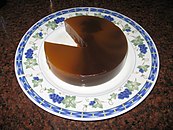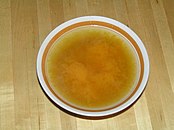
Naengmyeon or raengmyŏn is a noodle dish of North Korean origin which consists of long and thin handmade noodles made from the flour and starch of various ingredients, including buckwheat, potatoes, sweet potatoes, arrowroot starch, and kudzu. Buckwheat predominates. Other varieties of naengmyeon are made from ingredients such as seaweed and green tea.

Kimchi fried rice or kimchi-bokkeum-bap (김치볶음밥) is a variety of bokkeum-bap, a popular dish in South Korea. Kimchi fried rice is made primarily with kimchi and rice, along with other available ingredients, such as diced vegetables or meats like Spam.

Mak-guksu (막국수) or buckwheat noodles is a Korean buckwheat noodle dish served in a chilled broth and sometimes with sugar, mustard, sesame oil or vinegar. It is a local specialty of the Gangwon province of South Korea, and its capital city, Chuncheon. Jaengban-guksu is a type of makguksu in which buckwheat noodles and various vegetables are mixed in a tray.

Japchae is a savory and slightly sweet dish of stir-fried glass noodles and vegetables that is popular in Korean cuisine. Japchae is typically prepared with dangmyeon, a type of cellophane noodles made from sweet potato starch; the noodles are mixed with assorted vegetables, meat, and mushrooms, and seasoned with soy sauce and sesame oil.

Maeun-tang (Korean: 매운탕) or spicy fish stew is a dish in Korean cuisine. It is a hot spicy fish soup boiled with gochujang, '고춧가루'(chili powder), and various vegetables. The name is a combination of two words: '매운', which derives from '맵다', meaning "hot and spicy"; and '탕(湯)', meaning "soup". As its main ingredient, fresh or saltwater fish is cut into several pieces and boiled with green vegetables such as watercress and garland chrysanthemum. Onion, radish, chilis, crown daisy, garlic, and sometimes zucchini and bean curd are added to the mixture to absorb the chili pepper paste which is the main flavoring of this dish. It is then seasoned with chili powder, garlic, soy sauce, and additional gochujang may be added once more to taste.
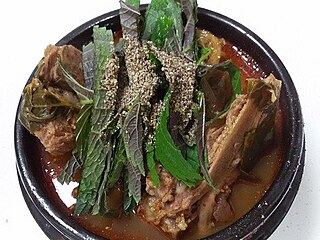
Gamja-tang (감자탕) or pork back-bone stew is a spicy Korean soup made from the spine or neck bones of a pig. It often contains potatoes, cellophane noodles, greens, perilla leaves, green onions, hot peppers and ground sesame seeds.

Tteokbokki (Korean: 떡볶이), or simmered rice cake, is a popular Korean food made from small-sized garae-tteok called tteokmyeon or commonly tteokbokki-tteok. Eomuk, boiled eggs, and scallions are some common ingredients paired with tteokbokki in dishes. It can be seasoned with either spicy gochujang or non-spicy ganjang -based sauce; the former is the most common form, while the latter is less common and sometimes called gungjung-tteokbokki.

Kal-guksu is a Korean noodle dish consisting of handmade, knife-cut wheat flour noodles served in a large bowl with broth and other ingredients. It is traditionally considered a seasonal food, consumed most often in summer. Its name comes from the fact that the noodles are not extruded, pulled, or spun, but cut.
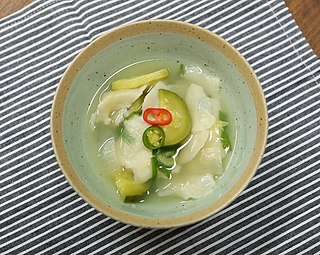
Sujebi, ttŭdŏ-guk, or hand-pulled dough soup, or Korean-style pasta soup, is a Korean traditional soup consisting of dough flakes roughly torn by hand, with various vegetables. The flavor and recipe resemble kalguksu, except that the latter is made with noodles rather than wheat flakes. It is commonly considered a dish to consume on rainy days, along with bindaetteok.

Bibim-guksu (비빔국수) or spicy noodles, is a cold Korean noodle dish made with very thin wheat flour noodles called somyeon (소면/素麵) with added flavorings, is one of the most popular traditional noodle dishes in Korean cuisine and especially popular during summer.

Kong-guksu (콩국수) or noodles in cold soybean soup is a seasonal Korean noodle dish served in a cold soy milk broth. In the Korean language, kong means soybean and guksu means noodles. It comprises noodles made with wheat flour and soup made from ground soybeans. It is unknown when Korean people started eating kongguksu; however, in accordance with the mention of the dish along with kkaeguksu in Siui jeonseo, a Joseon cookbook published around the late 19th century, it is presumed to have originated at least as early as the 19th century.
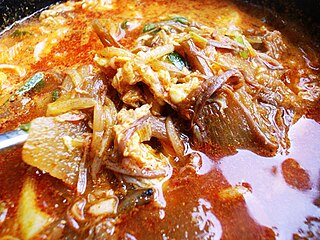
Yukgaejang or spicy beef soup is a spicy, soup-like Korean dish made from shredded beef with scallions and other ingredients, which are simmered together for a long time. It is a variety of gomguk, or thick soup, which was formerly served in Korean royal court cuisine. It is thought to be healthful and is popular due to its hot and spicy nature.
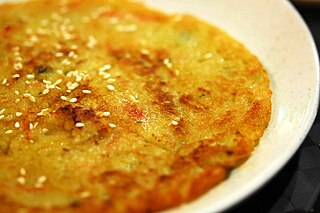
Gamja-jeon (감자전) or potato pancakes is a variety of jeon, or Korean style pancake, made by pan-frying finely grated potato on a frying pan with any type of vegetable oil until golden brown.

Dak-galbi (닭갈비), or spicy stir-fried chicken, is a popular South Korean dish made by stir-frying marinated diced chicken in a gochujang-based sauce with sweet potatoes, cabbage, perilla leaves, scallions, tteok, and other ingredients. In Korean, galbi means rib, and usually refers to braised or grilled short ribs. Dak-galbi is not made with chicken ribs, however, and the dish gained this nickname during the post-War era when chicken was used as a substitute for pork ribs. Many dak-galbi restaurants have round hot plates that are built into the tables. Lettuce and perilla leaves are served as ssam (wrap) vegetables.

Golbaengi-muchim (골뱅이무침) or moon snail salad is a type of muchim (salad) made by mixing moon snails with vegetables. In South Korea, it is an anju typically made with red, spicy sauce and served with boiled somyeon. Like other anju, it is sold in pojangmacha.

Nakji-bokkeum (낙지볶음) or stir-fried octopus is a popular dish in Korea that is relatively recent, with origins dating back only two centuries and first being introduced in the early 1960s.

Gyeran-mari (Korean: 계란말이), dalgyal-mari (달걀말이) or rolled omelette is a dish in Korean cuisine. It is a savory banchan made with beaten eggs mixed with several finely diced ingredients, then progressively fried and rolled. Common ingredients include vegetables, mushroom, processed meat, salt or salted seafood, and cheese. Optionally, gim (seaweed) is folded with the omelette. When served, the omelette is cut into 2–3 centimetres (0.79–1.18 in) slices. It is also a common anju found at pojangmacha.
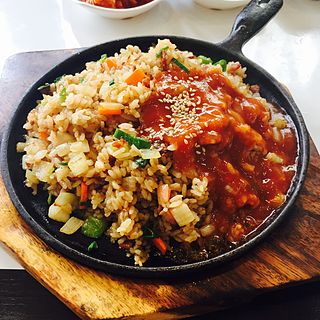
Bokkeum-bap (Korean: 볶음밥) or fried rice is a Korean dish made by stir-frying bap with other ingredients in oil. The name of the most prominent ingredient other than cooked rice often appears at the very front of the name of the dish, as in kimchi-bokkeum-bap.



